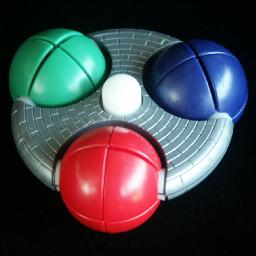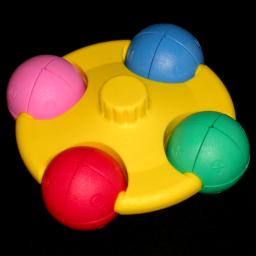Ufo / King Ring / Sando Ring
There are several puzzles called Ufo, but this one is
made by Netblock. It consists of a disc which is split into two layers which can
rotate about the central axis. Spaced evenly along the rim of the disc are 3 spheres
of different colours. These are split into octants, so that when the layers of the
disc are turned, one half of each sphere (4 pieces) travels with each layer. The
spheres can also rotate in two halves about an axis along the disc edge. Although
this puzzle is hard to describe, it is fairly easy to solve.
An earlier version is called King Ring, or Sando Ring.
This is much larger, uses bright colours, and has four spheres. It looks very much
like a toddler's toy.
The Ufo was patented on 13 May 1997 by Wai K. Chan, US 5,628,512.
The King Ring was patented on 21 March 1996 by Zoltan Pataki, Istvan Varadi, and Attila Kovacs,
WO 96/08297.
The number of positions:
Ufo: There are 24 pieces, 8 of each colour. They can therefore be arranged in
at most 24!/8!
3=9,465,511,770 ways. This limit is not reached
because:
- The pieces in the left halves and the right halves of the balls
never intermingle.
- The orientation of the puzzle itself is unimportant.
The first restriction means that there are at most 12!2 / 4!6
= 1,200,622,500 possible positions. The second restriction means that the
real number of positions is about 1/6th of that number because the puzzle
can be held in 6 different ways (due to the three-fold symmetry around the
centre, and because it can be turned over). As some positions
are themselves symmetric, the exact number can best be calculated with
Burnside's Lemma, and this gives
200,121,075 positions.
King Ring / Sando Ring:
There are 32 pieces, 8 of each colour. Using the same reasoning as above,
we get 16!2 / 4!8 = 3,976,941,969,000,000 positions.
The real number of positions is about 1/8 of this, and the exact number
iven by the Burnside Lemma is 497,117,746,919,592.
Links to other useful pages:
 Uwe Mèffert
Uwe Mèffert retails this puzzle, which is manufactured by Netblock.
Terminology:
Hold the puzzle so that one ball is at the front, nearest you, with
the other balls further away on the left and right. The four nearest
pieces of the front ball will be individually called the top-left, top-right,
bottom-left and bottom-right piece. The other 4 pieces of the front ball
won't be named separately. The outside pieces of the other balls will
also be described in the same way, for example the "top-right piece of the
left ball" etc.
Solution:
Phase 1: Solve the front ball.
In this phase the front ball will be solved. I will assume you will make
it red, though you could of course solve a different colour first.
- Find any red piece in one of the other balls.
- Turn it so that it lies in the bottom front of its ball.
- Rotate the bottom disc layer to bring the piece to the front ball, at either
the bottom left of the bottom right.
- Turn the piece up so that lies at the top left of top right.
- Turn the bottom disc layer back to its original position. This is not necessary when you are solving the first ball, only when solving later balls.
- Repeat steps a-e three more times, so that the top half of the front ball
is completely red. You may have to be a little selective in your choice
of pieces, since you want to do the steps twice for the left half and twice
for the right half of the ball.
- Turn over the puzzle, so that the solved red pieces are at the bottom of the front ball.
- Repeat steps a-e, so that the top half of the front ball also becomes red.
Phase 2: Solve the remaining balls.
- Hold one of the unsolved balls in front.
- Choose one of the remaining colours, and apply phase 1 with that colour.
- Repeat a-b until all the balls are solved.



